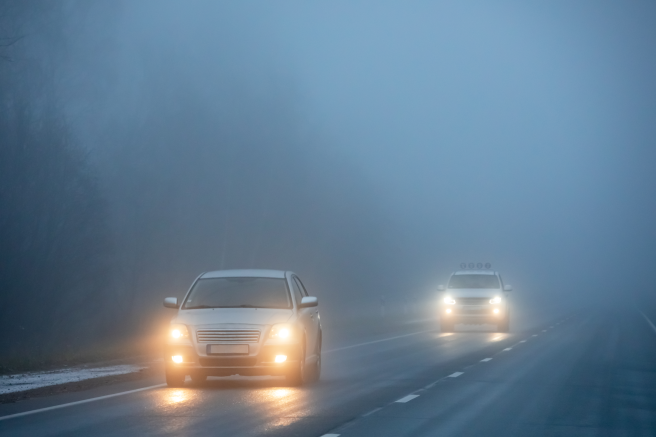You use your fog lights when driving in fog. Simple, right? Except many drivers use them when it’s not foggy and some people don’t even know where their fog lights are.
AGEAS’S EASY AS HACK
If driving visibility is less than the length of a football pitch, it’s time to turn on your fog lights.
AT A GLANCE
1. Fog lights are generally only needed when it’s foggy
2. If used at other times, they can mask your brake lights. You could even get a £50 fine for using your fog lights in the wrong way
3. The purpose of fog lights is to help other drivers see you, not for you to see in the fog
WHEN DO YOU NEED YOUR FOG LIGHTS ON?
It’s not always clear when fog lights are needed. It all comes down to the difference between fog and mist, which is a bit of a murky area. The Met Office says:
• Foggy is when you can see less than 1,000 metres ahead
• Misty is when you can see further than 1,000 metres
But from a driver’s perspective, visibility distances are much smaller. In fact, you should turn your fog lights on when visibility dips to 100m (328 feet) or less. That’s roughly the length of a football pitch and means the fog is reasonably thick. You should also use your headlights too, but not your full beam.
DO ALL CARS HAVE FOG LIGHTS?
Yes. Rear fog lights are required by law on all cars in the UK. Front fog lights are more likely to be found as an extra on higher-spec models. Some newer cars have daytime running lights (DRLs) instead of fog lights. These are the bright LED lights you see on new cars, which are permanently on and designed to make the car more visible to other road users.
While it’s not a legal requirement to use your fog lights, if they’re needed it’s safer to switch them on. Their purpose is to help make your car visible to others, rather than enabling you to see further in the fog.
However, whether or not you turn on your fog lights, always make sure your headlights are on in poor conditions, as that is a legal requirement.
HOW TO USE FOG LIGHTS
If you aren’t sure how to turn your fog lights on or off, spend a few minutes getting to grips with them while your car is stationary. That way you won’t suddenly have to figure it out one bleak winter’s morning when you’re in a rush.
Fog lights are usually operated by a separate switch from the main light controls. Look for a dashboard light coming on to let you know the fog lights are on. If in doubt, check your car’s manual. And if your car has automatic lights, don’t assume your fog lights will come on automatically too.
Don’t miss: Ageas’s top tips for driving on icy roads
ARE THERE ANY OTHER REASONS TO USE MY FOG LIGHTS?
Fog lights are for reduced visibility on the road, so you can also use them if visibility is less than 100 metres due to rain, snow or hail.
Remember, fog lights are to help other road users see you, not the other way around. So you will also need your headlights on low when driving in fog.
WHEN SHOULD I TURN MY FOG LIGHTS OFF?
Lots of drivers keep their fog lights on even when conditions are clear. But did you know that misuse of fog lights can result in a fine of up to £50?
The Highway Code says: “You must not use front or rear fog lights unless visibility is seriously reduced as they dazzle other road users and can obscure your brake lights. You MUST switch them off when visibility improves”.
ANY OTHER TIPS FOR DRIVING ON FOGGY DAYS?
The first and most important thing you need to do, is learn where your fog lights are, and how to recognise that you have them turned on while driving. The fog lights sign is usually a depicted by an oval headlight image, with a wavy line with three diagonal lights cutting through it to symbolise blocked vision.
Here are some other tips for driving in fog:
• Pay attention to live traffic updates
• Check your mirrors and slow down before entering fog
• Maintain a good distance from the vehicle in front
• If you see a sign saying ‘fog’, but the road seems clear, be prepared for a foggy patch up ahead
• Wind your windows down at junctions and crossroads so you can hear approaching traffic
• Expect to encounter other drivers not using their fog lights
• Do not tailgate other drivers going slowly in fog
• If conditions are extreme, park safely and wait until the weather improves to continue your journey
And remember to switch off your fog lights when the fog clears.
Don’t miss: Ageas’s full list of winter car maintenance tips.
Original article written by Ageas


